The uncertainty and challenges of a brain tumor diagnosis.
“You have a brain tumor”…I will never forget lying by myself in the ER awaiting my test results after a vertigo attack and onset of my first migraine ever and hearing these words. Brain tumor diagnosis. I could almost feel my heart stop, my breath slow, my limbs go cold and numb. I croaked out the words, “ What does that mean?”.
In reality, that would mean that my life would change forever, in many ways from that moment on.
For me, my brain tumor diagnosis with a non-malignant brain tumor, a colloid cyst, in the third ventricle of my brain, treatment meant becoming a ‘watch and wait’ patient. This is a term for monitoring the tumor on a regular basis using imaging, in my case MRI (Magnetic Resonance Imaging), to keep an eye on the size of the tumor and its impact on the brain and surrounding tissue.
I was introduced to the world of specialists that I had only ever heard about on Grey’s Anatomy, neurologists and neurosurgeons. This team was now responsible for the health and safety of my brain, the grey and white matter inside my skull.
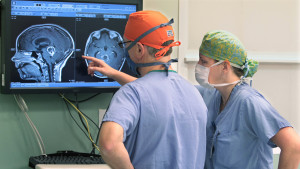
My vertigo attack and onset of my first migraine were the introduction to the beginning of my life of migraines. I was given medication to manage my migraines, which now just became part of my life.
Everything had now been taken care of from a medical standpoint; I had a neurosurgeon, a neurologist, and medication, regular MRI’s and was stable – I was in good hands. My brain tumor diagnosis was under control.
However, the one aspect that was outstanding and not as easy to deal with was the uncertainty.

“Uncertainty: something that is doubtful or unknown: something that is uncertain”
This could not be relegated to a list and ticked off.
From the first night that I was diagnosed, as much as I tried, the ‘what if’s’ of uncertainty started to spin around in my mind. What if I suddenly starting getting all these other symptoms that Dr. Google had told me about – which were completely legitimate and scientifically sound – but seemed overwhelming from short-term memory loss, seizures and behavioral changes to loss of consciousness and death.
My mind raced with various scenarios especially those that would impact my four-year old son and husband.
Living with the uncertainty was probably the hardest lesson for me to learn.
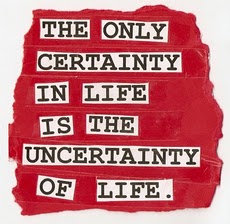
Eventually my learning was, that for me, by surrounding myself with family and friends and a solid and positive medical team, I was able to lower my levels of uncertainty about my diagnosis. I also got involved in some charity work on the sideline for Leukemia and Lymphoma, which involved training for a half marathon. This was a great way of focusing my mind on others who had health challenges as well as building my body to be a strong fighting machine! Science has shown the impact of walking on the brain and I could feel it.
These days, uncertainty continues to be in my life – but in a more positive way. There are many unknown variables that come my way, as is the case with any normal life! Because in life, there is one thing that is for certain: Change is the only constant. And with more change, comes more uncertainty. So how can we work with change and uncertainty and ride the wave, instead of battle against it?
This is no easy task!
So, I thought I could share a few tips that I used and still use during periods of uncertainty, especially after my diagnosis. Sometimes, having a list before you is often the easiest way to try out a few new things?
Tool Kit for Riding the Wave of Uncertainty
- Write it down and get it out
- There is something to be said for writing down the thoughts that keep flying around in your head and capturing them on a page – harnessing them from their manic flight. No one has to ever see them or hear them – just you. The health benefits of journaling are vast from clarifying your thoughts and feelings to just being able to put what you are thinking down and getting it out of your head and putting it to rest.
- Where to begin? Sometimes the actual thought of starting to journal is an obstacle in itself. But all you need is a pen and paper or your computer, a quiet space and five minutes to begin – so …start….Now!
- Connect
- Do you have a family member or close and reliable friend that you can connect with and have an honest conversation about your worries? You might be able to get a different point of view and also have the comfort of knowing someone supports you and is on your side. Human’s beings are creatures that need and thrive on connection, especially during periods of uncertainty.
- Release
- How can you release the tension and stress during this time of uncertainty? Is it going to gym, participating in your yoga class, hiking, reading, dinner with friends – schedule regular activities to allow your body (and mind) to release this stress in a healthy way.
- Calm
- Through periods of stress and uncertainty, the stress hormone cortisol rises rapidly. Another way to help lower cortisol in our body, apart from connecting and releasing, is through calming the brain through mindful meditation. Mindfulness is not just about meditation but actually more about focusing all your attention to the present and not the past and the future.
- Here are some user friendly apps to help you out in your mindful journey: https://www.calm.com/ http://stopbreathethink.org/ http://smilingmind.com.au/
Learning to ride the wave of uncertainty and change can be a challenging lesson for us all, but once we find our individual way to stand up and ride that wave – it can lead us to infinite possibilities and growth.
I love what mindfulness guru Jon Kabat-Zinn says about uncertainty,
“ You cannot stop the waves, but you can learn to surf”.
What technique are you going to use to help you learn to surf?



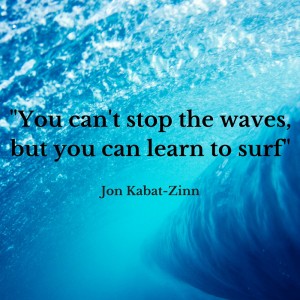
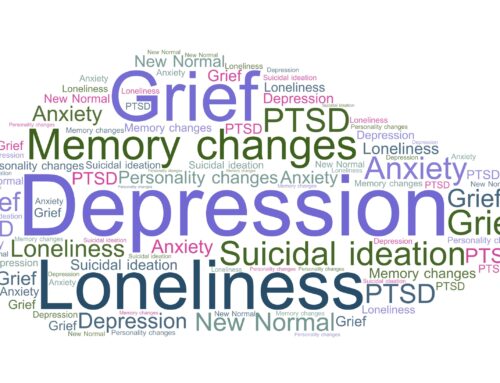



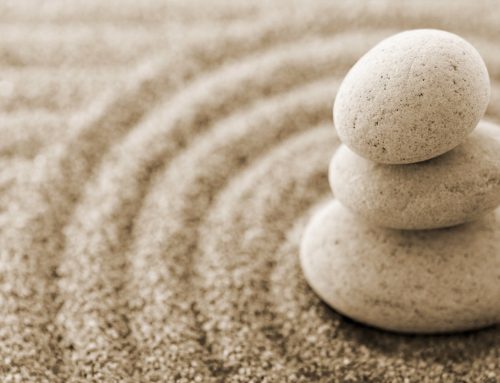
Leave A Comment